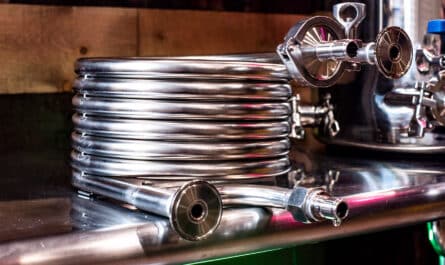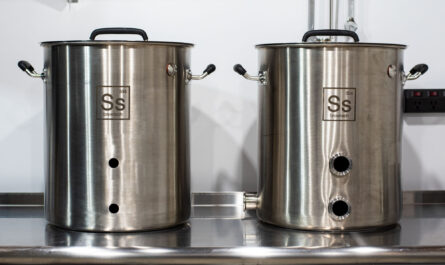I recently upgraded to a stainless conical unitank fermenter so I wanted to touch on my personal opinion on whether or not they’re worth the extra hefty price tag and cleaning. Conicals come with a long list of advanced features and pros and cons. When speaking of conicals, there are two basic types—the cheaper plastic fermenters and the more expensive stainless steel vessels. These are not to be confused with stainless bucket fermenters with a shallow cone. A true conical has a steeply sloped cone with a bottom dump valve. For the purposes of this article, I’m strictly focusing on pro-grade stainless conical fermenters available to homebrewers.
Here are some quick pros and cons before I dive into some more specifics:
Pros
- Pro brewer control over fermentation
- lots of features and accessories
- Easy pressure transfers/zero oxygen transfers
- Fermenting/dry hopping under pressure
- Carbonate and ferment in the same vessel
- No racking/transferring needed until ready to package
- Trub dumping and yeast harvesting
- Stainless is better for cleaning and sanitation
Cons
- Learning curve
- Very expensive
- Lots of components and valves to clean
- Bulky and require large fridges or glycol
Unitank Verses Conical
All unitanks are conicals, but not all conicals are unitanks. I think it’s important to understand the difference between a conical and a unitank. Unitanks are conical fermenters that are typically pressure-capable up to 15 PSI. Unitanks enable you to ferment, carbonate and serve from a singular vessel. Unitanks are the most expensive fermentation vessels available to homebrewers. Some of the major players on the market today are Ss Brewtech, Spike, BrewBuilt, Brewer’s Hardware, and Blichmann.
Ss Brewtech offers a more affordable Chronical line of fermenters that are pressure capable up to 1-2 PSI. This is just enough for basic pressure transfers but obviously cannot be used for pressure fermentation or carbonation.
Why Use A Conical?
The biggest advantage of using a conical is the ability to easily separate and dump trub and harvest yeast. While these aren’t the only benefits, they’re certainly the most obvious. While you can certainly harvest yeast in a bucket or carboy, it’s not nearly as easy or effective.
Trub dumping allows you to remove yeast post-fermentation allowing you to perform extended conditioning without the risk of old or dead yeast introducing off-flavors. While this isn’t really a concern for most ales, it does give you a lot of flexibility. Yeast harvesting can help to save a lot of money by reusing yeast! Yeast is of course one of the more expensive ingredients in brewing so it’s nice to be able to easily remove, store and repitch from batch to batch.
Conicals make eliminating oxygen at various stages of fermentation really easy, especially when it comes to transfers from fermenter to keg. While you really only need 1-2 PSI to transfer beer with CO2, it’s a lot easier in a vessel with a true pressure-capable lid. I’ve attempted this is stainless bucket fermenters and run into leaks and complications.
Conicals come equipped with sanitary tri-clover fittings that enable you to add lots of accessories. This includes aerations/carbonation stones, pressure gauges and gas posts, blow-off canes, spunding valves, sampling valves, and dry hoppers. This obviously gives you tremendous control and a vast array of interchangeable components.
Conicals help with better process control and a smoother workflow. Because I have both heating and cooling capability, it makes precision and repeatability much easier as well. The more sophisticated the equipment, the fewer external variables come into play.
Unitanks allow you to ferment under pressure and naturally carbonate your beer. Pressure fermentation allows you to ferment in warmer ambient temps while suppressing ester production. This is beneficial for those who don’t have a glycol system or a large enough fridge. Pressure fermentation also allows you to produce lagers at ale temperatures.
Scale really comes into play when choosing a fermenter. If you’re looking to scale up to 15+ gallon batches, a conical is really your only feasible option. Scale is a major reason why brewers switch to state-of-the-art vessels. If they made 20-gallon buckets maybe it would be a different story?!?
Downsides
The only real downsides of a conical fermenter is the steep price tag, increased learning curve, and more complicated cleaning process. While some days I miss being able to simply soak my bucket in the sink, it’s not nearly enough to offset the many benefits I enjoy.
Conicals of course have more components that need to be cleaned, sanitized, and stored. But in all honesty, they’re not as complex as they may seem at first glance. Brewing is always going to come with extensive cleaning and sanitization. Luckily clean in place (CIP) practices do a really good job of making cleaning easy and even comes with their own benefits.
Due to their size, most conicals require a very large fermentation chamber or glycol system to maintain fermentation temps. This is the other very pricey part of the equation as cooling solutions can be equally as expensive. The good news is most glycol units can be used to cool multiple fermenters.
While I can’t say there are true downsides to actually fermenting in a conical, it can make your brew day longer and of course, comes with a cost.
Better Beer?
Can a conical really produce better beer than a plastic bucket? I think it honestly depends on what you’re brewing. Conicals really shine when it comes to brewing delicate styles like IPAs or NEIPAs. When eliminating oxygen is the number one priority, a conical gives you the absolute most control. Conicals are of course always going to be the more sophisticated piece of equipment for the job, but the truth is you may not always be able to taste the difference. A conical alone will not make an award-winning beer, a conical just enables you to make award-winning beer a little easier.
If you’re someone like me who brews a lot of IPAs, a conical will be incredibly beneficial to you. While you may be able to achieve similar results in a bucket, it’s going to take tremendous care and results will greatly vary. Fermentation is arguably the most important stage of the brewing process, so it makes total sense to invest more in the cold side.
My Advice
At the end of the day, you need to determine what’s worth it to you. I can’t say anyone who purchases a conical really ever ends up disappointed. The other side of the equation is homebrewers’ are always aspiring to be just like the pros. There is certainly the thrill of gadgets, shiny vessels, and wanting the same level of capability and control as a commercial brewery. It’s honestly part of the fun of the hobby.
If you’re going to spend your money on anything, I’d always emphasize the cold side over the hot side. For what it’s worth, I love my conical and I’d never go back to fermenting in anything else. For everyone scratching their heads why you would possibly spend so much money on a single piece of equipment, I’d equate it to the same reason we love and spend money on sports cars. Because they’re highly sophisticated pieces of machinery that look awesome and get you from A to B in complete style.





I’ve never used a conical for homebrewing, but as a professional brewer, I’d say that CIP practices make cleaning far easier than anything you can do with a carboy. Gone are the brushes to reach hard to reach spots, gone is lifting heavy, breakable vessels to dump them out, you just set your pump up, add your water and chemical, and then basically set it and forget it.
In every brewery I’ve ever worked in, running a CIP cycle is a good time to accomplish other tasks or just take time to eat lunch or whatever.
The only downside, for the novice, is that tri clamps are difficult – at first. After a couple months working in a brewery, they became second nature to me, and while it’s probably a little different for a homebrewer who isn’t using them every day, it’s still simple with practice.
That being said, when I do home brews, I still use buckets and carboys. I don’t make IPAs, because I find them boring, I don’t think they’re the best way of demonstrating brewing skills/knowledge, and the market is saturated already – I prefer brewing beers that I can’t buy, beers that I can’t brew at work because they may appeal to a beer nerd like me, but won’t appeal to 90% of customers. For my homebrew purposes, a bucket/carboy and a fridge with a heating element for temperature control is all I need. But if you can afford it and have the space, by all means, buy a conical. They make things a lot easier.
I am curious about the types of beer you like to brew.
At this point – mainly IPAs, especially NEIPAs. Essentially the most conical-worthy beers out there besides lagers in my opinion. Those are next on the list of styles to master!